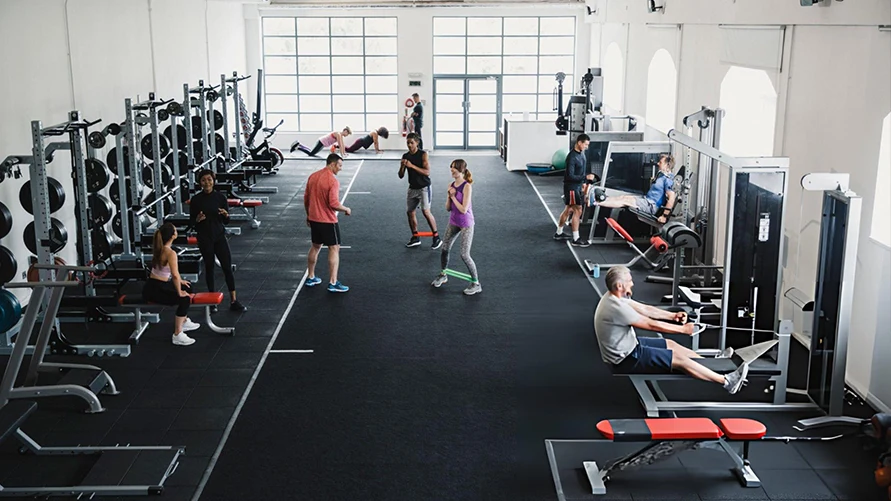Gym owners often face challenges when dealing with lazy members, which can significantly impact their business. Lazy members may lack motivation, consistency, and commitment, leading to the underutilization of gym facilities and decreased attendance.
This affects the overall atmosphere and energy within the gym and hampers the sense of community and camaraderie among members. Moreover, lazy members may require additional attention and support, diverting resources and time away from other members.
From a business perspective, the impacts can include decreased revenue due to low membership retention and potential negative word-of-mouth. It can also affect the gym’s reputation, making it challenging to attract new members. Therefore, addressing the challenges associated with lazy members is crucial for maintaining a thriving gym business.
However, gym owners must understand that everyone has different motivations and challenges when staying committed to a workout routine. In this article, we are exploring a few practical strategies that can help you as a gym owner to deal with lazy members and upkeep your gym’s reputation in the market.
Different practical strategies for dealing with lazy gym members?
To help you as a gym owner, here are some strategies to help with lazy buns in the gym. Let’s get started on how this works.
1. Offer personalized support
As a gym owner, showing your members that you care about their progress is crucial to building a strong relationship with them and keeping them motivated. So, when your lazy gym members feel supported and encouraged, they are more likely to maintain their workout regimen and become loyal consumers.
Here are tips to provide personalized support to deal with lazy gym members:
Individualized goal setting
Take the time to understand your each gym member’s goals and aspirations. Help them set realistic and achievable targets based on their preferences and fitness levels. By personalizing their goals, you can create a sense of purpose and inspiration, making it easier for them to stay determined and overcome laziness.
Tailored workout programs
Design personalized workout programs that cater to lazy gym members’ specific needs and interests. Consider their fitness level, preferred activities, and any limitations they may have. By providing tailored workouts that align with their capabilities and preferences, you increase the chances of them enjoying their workouts and staying consistent.
Regular check-ins and accountability

Stay actively involved in the progress of lazy gym members by scheduling regular check-ins. This can be through one-on-one sessions, progress assessments, or virtual meetings. Regular check-ins provide accountability and support, ensuring they stay on track and helping them overcome laziness through encouragement and guidance.
Motivational and inspirational support
Share success stories and motivational content with lazy gym members to inspire and motivate them. This can include testimonials from other members who have overcome similar challenges or stories of transformation and achievement. You can help them overcome their laziness and strive for better results by showcasing the possibilities and highlighting the benefits of consistent effort.
Positive reinforcement and rewards
Recognize and reward the efforts and progress of lazy gym members. Celebrate milestones, advancements, and achievements to strengthen their positive behavior and build their morale. Positive support can be in the form of verbal praise, small incentives, or even public acknowledgment. Creating a positive and supportive environment motivates lazy gym members to push through their laziness and continue their fitness journey.
By implementing these tips for personalized support, you can effectively address the challenges of lazy gym members and help them develop a consistent fitness routine. Remember, empathy, understanding, and a personalized approach are key to motivating individuals who struggle with laziness. With your guidance and support, these members can break free from their inertia and achieve their fitness goals.
2. Create a positive environment

A positive and supportive gym environment can benefit individuals seeking to improve their fitness and overall well-being. Here are the advantages of a positive gym environment: Tips are offered on encouraging social interactions, and suggestions are given on organizing group fitness classes or challenges.
Here are some benefits of promoting a positive environment at your gym to deal with lazy gym members:
Enhanced social interaction
A supportive gym environment fosters a sense of community, which can lead to increased social interaction and networking opportunities. Social interaction can significantly help a lazy gym member by providing several ways, such as:
- Accountability and peer support: Social interaction creates a sense of accountability among gym members. Having workout buddies or participating in group activities provides peer support, encouragement, and a shared sense of commitment. When people know that others are anticipating them to show up and partake, they are more likely to overcome laziness and commit to their fitness routine.
- Motivation and inspiration: Interacting with other motivated and active individuals can be a powerful source of motivation and inspiration for lazy gym members. Seeing others’ dedication, progress, and positive mindset can ignite a spark within them, encouraging them to step up their efforts and overcome their laziness.
- Healthy competition: Social interaction can introduce a healthy level of competition among gym members. It creates an environment where members challenge each other to improve, fostering a sense of achievement and personal growth. Friendly competition can drive lazy individuals to push beyond their comfort zone and strive for better results.
- Support and encouragement: Social interaction offers a platform for receiving support and encouragement from fellow gym members. Encouragement from peers can boost their confidence, self-belief, and willingness to overcome laziness. When lazy individuals engage with others who understand their struggles and offer guidance, they feel supported and less alone in their fitness journey.
Social interaction is crucial in helping lazy gym members overcome their inertia and become more active. It provides accountability, motivation, support, and inspiration while fostering a sense of belonging and healthy competition. By actively engaging with others, lazy members can find the encouragement and drive they need to overcome their laziness and progress toward their fitness goals.
Improved mental health

Gym owners can provide a transformative experience for lazy members by creating a positive environment that promotes mental health. Improved mental health leads to increased motivation, focus, self-confidence, stress reduction, and overall well-being. This strong foundation can help lazy members overcome challenges and become more active in their fitness routines.
Here’s how it can help:
- Increased motivation and mental energy: A positive gym environment can contribute to improved mental health by fostering positive emotions, reducing stress, and boosting motivation. When lazy gym members experience positive emotions and reduced stress levels, they are more likely to have the mental energy and drive to overcome their laziness and engage in their workouts.
- Enhanced focus and concentration: Positive gym environments promote a sense of focus and concentration. Members who struggle with laziness often find it difficult to maintain focus and stay committed to their fitness routine. By creating an atmosphere that cultivates focus and concentration, lazy members can better direct their attention toward their workouts, leading to increased participation and effort.
- Boosted self-confidence: A positive gym environment can significantly impact self-confidence. When lazy members experience a supportive and non-judgmental atmosphere, they feel more confident in their abilities and are less likely to be hindered by self-doubt. This increased self-confidence can motivate them to overcome their laziness and take on new challenges in their fitness journey.
- Stress reduction and improved mood: A positive gym environment can reduce stress and improve mood through various factors such as social support, encouragement, and enjoyable workout experiences. Lazy members who may be battling low motivation and negative moods can benefit from a positive gym environment that helps alleviate stress and promotes a more positive outlook, making it easier for them to engage in their workouts.
3. Incentivize members

Rewards and incentives can be powerful tools to motivate gym members to reach their fitness goals. You can help members stay motivated and committed to their exercise regimen by offering tangible rewards.
Effectiveness of rewards and incentives
Offering rewards and incentives can be an effective way to motivate gym members to achieve their fitness goals. Rewards can provide a sense of accomplishment and a great way to track progress. Incentives such as discounts, free merchandise, or free sessions can motivate members to maintain their gym attendance and stick to their fitness routines.
Tips for structuring rewards programs
Establishing specific and attainable goals is crucial to designing a successful incentive scheme. The objectives must be time-bound, relevant, quantifiable, reachable, and explicit. When members succeed in their objectives, they ought to be given a gratifying reward, such as a discount or a free session. One strategy could be committing to going to the gym thrice weekly for a month.
It’s also essential to ensure the rewards program is fair and transparent. Members should be aware of the rewards and incentives available to them and how to achieve them. The criteria for attaining rewards should be clearly outlined, and members should be informed of their progress toward their goals.
Transparency and fairness in reward programs
Transparency and fairness are essential when it comes to rewards programs. Members should feel that the program is fair and have an equal reward opportunity. Also, it’s vital to ensure that the criteria for achieving rewards are objective and not based on subjective factors. Rewards should not be based on gender, race, or age.
Rewards and incentives can be powerful motivators for gym members. By setting clear, achievable goals and offering tangible rewards, you can help members stay motivated and committed to their fitness goals. Also, it’s crucial to ensure that rewards programs are transparent and fair and that all members have an equal opportunity to earn rewards.
4. Communicate regularly
Regular communication is essential in keeping gym members engaged and motivated. By staying in touch with members, gym owners can build a sense of community, provide information about upcoming events and new programs, and encourage members to remain committed to their fitness goals.
Importance of regular communication
Regular communication helps to build trust and rapport with members. It allows gym owners to stay connected with members and understand their needs and preferences. By keeping members informed about upcoming events and new programs, gym owners can encourage participation and keep members engaged in their fitness journey.
Tips for sending regular emails or newsletters
It’s essential to create and stick to a schedule to send regular emails or newsletters. This might involve sending a weekly or monthly newsletter or periodic updates about upcoming events and promotions. It’s essential to ensure that the content is relevant and valuable to members and reflects the gym’s values and culture.
Moreover, gym owners can increase engagement and participation by tailoring communication to members’ needs and preferences. This might involve addressing members by name or segmenting communication-based on interests or activity level. In addition, it’s essential to personalize communication as much as possible.
Using clear and concise language
When communicating with members, using clear and concise language is essential. This means avoiding jargon or technical terms and using simple and easy-to-understand language. It’s also necessary to use a conversational tone and avoid sounding overly formal or stiff.
Conclusion
Lazy gym members can be a significant challenge for gym owners, but with the right strategies, it’s possible to turn them into regular attendees and loyal customers. By showing personalized support, creating a positive gym atmosphere, incentivizing members to use technology, and communicating regularly, gym owners can create a welcoming and supportive gym environment that encourages all members to achieve their fitness goals.





